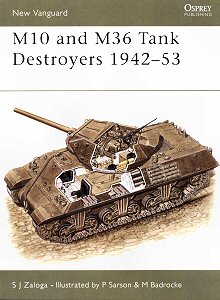

 M10
and M36 Tank Destroyers 1942-53
M10
and M36 Tank Destroyers 1942-53
by Steven J Zaloga,
Illustrated by Peter Sarson and Mike Badrocke
New Vanguard No 57
Osprey Publishing, Elms Court, Chapel Way, Botley, Oxford OX2 9LP
ISBN 1-84176-469-8
38 pages, soft cover
Review by Peter Brown
This was M10 series, based on the chassis and mechanical components of the M4-series Sherman tank which was being built in large numbers. It differed from its tank cousin in that it had a bigger and far more powerful gun but to keep the overall weight down it only had thin armour and an open-topped turret. Employed for the first time in Tunisia in 1943 it had some initial success although it was only rarely used in large numbers to fend off massed tank attacks as there were few such attacks by the time it was available. It did prove valuable not only in its intended antitank role but also as in the secondary task of general artillery support.
Its design, development and use is described, including changes to the turret mainly to balance the long and heavy gun. Very useful here are the dates of introduction and numbers built of the three main turret types, those without counterweights which were fitted with various expedient weights and the early and late pattern with wedge-shaped weights. Most of the use covered is with American units but there is coverage of those supplied to the Allies, mostly British and the Commonwealth countries with some details on the small number sent to the Soviet Union. The one major variant was the British version re-armed with the 17-pounder and its production and use is related as well.
Throughout WW2 there was a leapfrog race between armour and guns and this lead to the more powerful 90mm gun being introduced and with it a completely new turret to produce the M36. This new vehicle came into use in the closing months of 1944 alongside the older M10s and figures showing use and losses follow the use of both types. The Sherman-based M36B1 and improved M36B2 are also described, also post-war use of both series which extended for many years with a few M36-series vehicles surviving in modified form in action in the Balkans in the 1990s.
The text is supported by black and white photos showing the main vehicle types and including some detail close-ups and interior views. In Osprey's usual style we also have colour plates showing typical colour schemes for both wartime and post-war use as well as the trademark cutaway, including a Canadian M10 17pdr version and Turkish and Yugoslavian M36's.
With M10 kits available now and a new large-scale M36 promised for sometime soon, this is a well-timed book which will strongly appeal to modellers. Well up to the usual standards of the series and the author own.
Page Created 4 August 2002